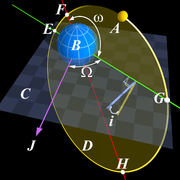
Celestial mechanics

Celestial mechanics is the branch of astronomy that deals with the motions of objects in outer space. Historically, celestial mechanics applies principles of physics (classical mechanics) to astronomical objects, such as stars and planets, to produce ephemeris data. Celestial mechanics is the branch of astronomy that deals with the motions of objects in outer space. Historically, celestial mechanics applies principles of physics (classical mechanics) to astronomical objects, such as stars and planets, to produce ephemeris data. Modern analytic celestial mechanics started with Isaac Newton's Principia of 1687. The name 'celestial mechanics' is more recent than that. Newton wrote that the field should be called 'rational mechanics.' The term 'dynamics' came in a little later with Gottfried Leibniz, and over a century after Newton, Pierre-Simon Laplace introduced the term 'celestial mechanics.' Prior to Kepler there was little connection between exact, quantitative prediction of planetary positions, using geometrical or arithmetical techniques, and contemporary discussions of the physical causes of the planets' motion. Johannes Kepler (1571–1630) was the first to closely integrate the predictive geometrical astronomy, which had been dominant from Ptolemy in the 2nd century to Copernicus, with physical concepts to produce a New Astronomy, Based upon Causes, or Celestial Physics in 1609. His work led to the modern laws of planetary orbits, which he developed using his physical principles and the planetary observations made by Tycho Brahe. Kepler's model greatly improved the accuracy of predictions of planetary motion, years before Isaac Newton developed his law of gravitation in 1686. Isaac Newton (25 December 1642–31 March 1727) is credited with introducing the idea that the motion of objects in the heavens, such as planets, the Sun, and the Moon, and the motion of objects on the ground, like cannon balls and falling apples, could be described by the same set of physical laws. In this sense he unified celestial and terrestrial dynamics. Using Newton's law of universal gravitation, proving Kepler's Laws for the case of a circular orbit is simple. Elliptical orbits involve more complex calculations, which Newton included in his Principia. After Newton, Lagrange (25 January 1736–10 April 1813) attempted to solve the three-body problem, analyzed the stability of planetary orbits, and discovered the existence of the Lagrangian points. Lagrange also reformulated the principles of classical mechanics, emphasizing energy more than force and developing a method to use a single polar coordinate equation to describe any orbit, even those that are parabolic and hyperbolic. This is useful for calculating the behaviour of planets and comets and such. More recently, it has also become useful to calculate spacecraft trajectories. Simon Newcomb (12 March 1835–11 July 1909) was a Canadian-American astronomer who revised Peter Andreas Hansen's table of lunar positions. In 1877, assisted by George William Hill, he recalculated all the major astronomical constants. After 1884, he conceived with A. M. W. Downing a plan to resolve much international confusion on the subject. By the time he attended a standardisation conference in Paris, France in May 1886, the international consensus was that all ephemerides should be based on Newcomb's calculations. A further conference as late as 1950 confirmed Newcomb's constants as the international standard. Albert Einstein (14 March 1879–18 April 1955) explained the anomalous precession of Mercury's perihelion in his 1916 paper The Foundation of the General Theory of Relativity. This led astronomers to recognize that Newtonian mechanics did not provide the highest accuracy. Binary pulsars have been observed, the first in 1974, whose orbits not only require the use of General Relativity for their explanation, but whose evolution proves the existence of gravitational radiation, a discovery that led to the 1993 Nobel Physics Prize. Celestial motion, without additional forces such as thrust of a rocket, is governed by gravitational acceleration of masses due to other masses. A simplification is the n-body problem, where the problem assumes some number n of spherically symmetric masses. In that case, the integration of the accelerations can be well approximated by relatively simple summations. In the case that n=2 (two-body problem), the situation is much simpler than for larger n. Various explicit formulas apply, where in the more general case typically only numerical solutions are possible. It is a useful simplification that is often approximately valid.
